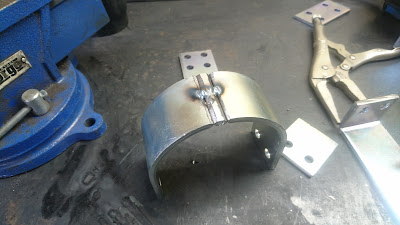Sometimes when idiots like me build cars, they don't get everything right and the cars self destruct. One of the many dangerous ways cars can self destruct is by spitting out a driveshaft. This can happen when a driveshaft or U-joint breaks.
Sometimes a driveshaft will break because there is too much torque going through the drivetrain. I don't think this engine will make so much torque or the tires will be so sticky that the driveshaft will tear itself in half, but it's possible that the angles aren't just right, or the shortened driveshaft isn't balanced right, or there is a welding issue... any number of things could be wonky. In an attempt to contain the driveshaft should things go haywire, I've installed a driveshaft loop.
NHRA rules require a driveshaft loop on any vehicle that runs the quarter mile quicker than 13.99-seconds while running slicks or quicker than 11.49-seconds on street tires. Since this car isn't built to be a drag racer, it's not likely that either of these situations will happen, but I do want that peace of mind. So like usual, I bought a kit and immediately started slicing and dicing. The rest is pretty self explanatory.
Just the other day I decided it was finally time to reinstall the old Grace-face. She's been without it since May of 2013. That's almost four years exactly. A lot has changed since then. A whole lot. I had barely just started the project. I was still single. I hadn't even met my wife at that point. I hadn't started getting fat yet. There was still a Backyard Steve. Man, I sorta miss Backyard Steve. I'll never forget one time when I came home from work and while chatting with Backyard Steve I noticed two thick scabs on his knee. He could tell that I was staring at his knee so he volunteered an explanation. "Oh yeah, that..." Backyard Steve said "I was doing business with a guy and he tried to cheat me, so I pulled my gun on him. It's a .22 pistol. While I was pulling the gun out I shot myself in the knee." He pointed at the scab above the kneecap "The bullet went in here", he then pointed at the scab below the kneecap "and went out here. It's ok though, I clobbered him with the butt of my gun. Cracked his skull." Who knows if the story was true, but life was more colorful back then.
 |
| May 2013 |
 |
| May 2017 |






















